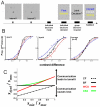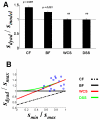Optimally interacting minds
- PMID: 20798320
- PMCID: PMC3371582
- DOI: 10.1126/science.1185718
Optimally interacting minds
Abstract
In everyday life, many people believe that two heads are better than one. Our ability to solve problems together appears to be fundamental to the current dominance and future survival of the human species. But are two heads really better than one? We addressed this question in the context of a collective low-level perceptual decision-making task. For two observers of nearly equal visual sensitivity, two heads were definitely better than one, provided they were given the opportunity to communicate freely, even in the absence of any feedback about decision outcomes. But for observers with very different visual sensitivities, two heads were actually worse than the better one. These seemingly discrepant patterns of group behavior can be explained by a model in which two heads are Bayes optimal under the assumption that individuals accurately communicate their level of confidence on every trial.
Figures




Comment in
-
Behavior. Decisions made better.Science. 2010 Aug 27;329(5995):1022-3. doi: 10.1126/science.1194920. Science. 2010. PMID: 20798305 No abstract available.
-
Optimizing scientific reasoning.Science. 2010 Dec 10;330(6010):1477. doi: 10.1126/science.330.6010.1477-b. Science. 2010. PMID: 21148374 No abstract available.
References
-
- Bovens L, Hartmann S. Bayesian epistemology. Oxford University Press; Oxford: 2003.
-
- Nitzan S, Paroush J. Collective decision making: an economic outlook. Cambridge University Press; Cambridge: 1985.
-
- Alais D, Burr D. Curr. Biol. 2004;14:257. - PubMed
-
- Ernst MO, Banks MS. Nature. 2002;415:429. - PubMed
-
- Kording KP, Wolpert DM. Nature. 2004;427:244. - PubMed
Publication types
MeSH terms
Grants and funding
LinkOut - more resources
Full Text Sources

